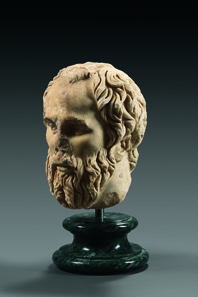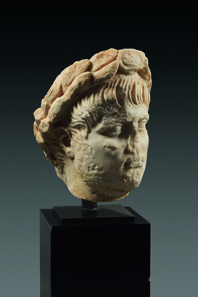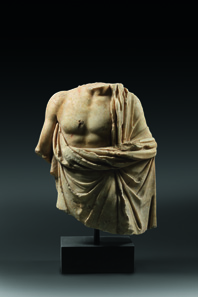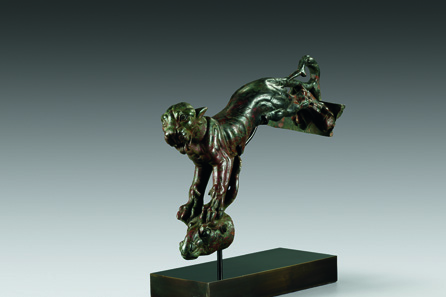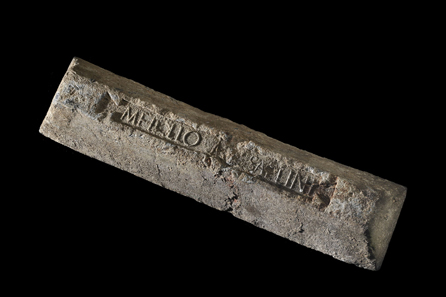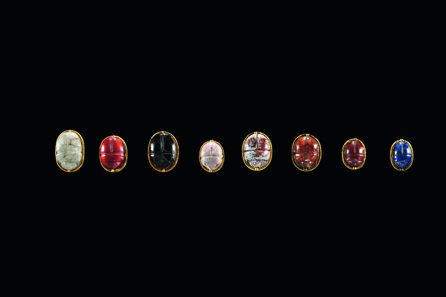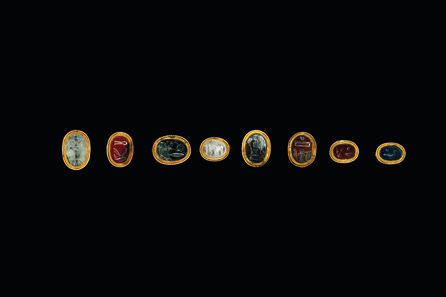18-06-2013 – 01-01-1970
Auction sale 214: Ancient Art
Ancient treasures at Gorny & Mosch
Something for everybody – this positive promise is given by the upcoming auction sale of ancient art at Gorny & Mosch. A broad range will be offered for sale with something available for every budget, from a gorgeous bronze hollow cast of two pantheresses in a quality that would suit a museum for a five-figure sum to ancient necklaces for 400 euros. Collecting ancient art is not a privilege of a fortunate elite but financially manageable for everyone. Admittedly, in this preview we restrict ourselves, again, to the spectacular items.
Lot 1: Head of a philosopher. White, finely-crystalline marble, 2nd half of 2nd cent. A. D. H. 30 cm. Provenance: purchased from French private collection. Estimate: 65,000 euros.
Let us start with the head of a bearded philosopher (lot 1) whose ascetic facial features couldn’t yet be associated with any of the known philosopher portraits. The magnificently preserved head, that dates to the 2nd cent. A. D. and is made from white finely-crystalline marble, exhibits some breakages and nicks only on some insignificant parts (estimate: 65,000 euros).
Lot 5: Head of Nero. White, finely-crystalline marble. H. 30 cm. Provenance: from Jan Adler Collection. Estimate: 40,000 euros.
Surely a favorite object of anyone historically interested is the life-size head of Emperor Nero (lot 5), likewise made of finely crystalline marble. The emperor with his characteristic downy whiskers wears a bulky laurel wreath which is decorated with a central jewel over the forehead (estimate: 40,000 euros).
Lot 7: Torso of a statuette of Asklepios Giustini. White, finely-crystalline marble, 2nd cent. A. D.; H. 45 cm. Provenance: From Swiss private collection, purchased in 1985. Estimate: 30,000 euros.
The smaller than life-size torso of a statuette of healing deity Asklepios (lot 7) from the 2nd cent. A. D. can be associated with the widely distributed Asklepios Giustini Type (estimate: 30,000 euros). Present-day scholars believe that these are copies of the cult image that was set up in Athens when the cult, originating in Epidauros, was introduced there in 420/419 B. C.
Lot 11: Decorations of a war chariot in the shape of two pantheresses. Bronze hollow cast, 1st/2nd cent. A. D.; L. about 44 cm each. Provenance: G. O. Collection, London. Auction Christie’s October 25, 2012. Estimate: 100,000 euros.
The sale’s most expensive item is a perfectly preserved bronze hollow cast with the finest patina from the 1st/2nd centuries depicting two pantheresses (lot 11) that once served as decoration of a war chariot (estimate: 85,000 euros).
He who is fond of ancient vase painting ought to have a look at the Attic eye-cup that was produced around 520 B. C. and is attributed to the Painter of the Kevorkian Oinochoe (lot 27). The professionally restored and near-complete piece depicts in numerous illustrations the journey of Heracles to Mt. Olympus (estimate: 15,000 euros).
Lot 25: Roman lead ingot, 1st cent. A. D., presumably Illyria. 40.1 kg. L. 46.3 cm (top), 51.8 cm (bottom), B. 5.3 cm (top), 13.0 cm (bottom). H. 9.0 cm. Provenance: The former owner purchased it in Austria in 1976. Estimate: 25,000 euros.
A very special object that might be of interest to coin collectors as well is a Roman lead ingot (lot 25) from the 1st cent. A. D. (estimate: 25,000 euros). It is a testimony to the fact that, when possessing a certain amount of expert knowledge, one can still make trouvailles. It was found on a scrapyard in Austria and saved from being melted down.
Lead was an important raw material in Rome that wasn’t only used for water pipes. Nevertheless it was a waste product after all of the silver industry. In all probability, Messallinus, whose name is written on the lead ingot (METALLO MESSALLINI), hasn’t just got lead out of his mine. It is very likely that this Messallinus was in fact Marcus Valerius Messalla Messallinus who held the consulship in 3 B. C. He served as governor of Illyria which had been seized shortly before. And he was closely related to Augustus: he had married Augustus’ niece. It is easy to imagine that Emperor Augustus had ceded land in the new territories to his relative on which a mine was located. If you like to learn more about the connection between silver and lead we recommend reading Lindsey Davis’ ‘The Silver Pigs’.
Lot 36: Group of stone scarabs with original gold frame. New Kingdom, 18th dynasty, around 1350 B. C. a) Jasper. L. 1.9 cm. b) Rock crystal. L. 2.2 cm. c) Obsidian. L. 1.8 cm. d) Crystalline limestone. L. 1.7 cm. e) Carnelian. L. 2.0 cm. f) Carnelian. L. 1.8 cm. g) Lapis lazuli. L. 1.5 cm. h) Jasper. L. 1.6 cm. 8 objects in a masterfully worked original ancient gold frame. From O. W. Collection, Munich. Estimate: 24,000 euros.
And if you prefer reading Elizabeth Peters you will surely favor the group of Egyptian stone scarabs with original gold frame from the 18th dynasty (lot 36). Red jasper, rock crystal, obsidian, limestone, carnelian and lapis lazuli: these precious materials were used for the scarabs and skillfully framed in gold after the carving was done. The group comprises eight pieces of a quality that is hard to come by on the market (estimate: 24,000 euros).
Speaking of Egypt – all aficionados of this advanced civilization will discover many special objects in the current catalog, also for considerably less money. Two big private collections will be liquidated by Gorny & Mosch in auction sale 214. The series of ushabtis is remarkable. Let us only make reference to an overseer ushabti from the 3rd Intermediate Period, the 19th-21st dynasty (lot 516). The standing figure with its well preserved glaze is made of dark-red clay with paint added (estimate: 1,600 euros).
Many more objects could as well be singled out here: an intact Achaemenid silver bowl (lot 32, estimate: 10,000 euros), a late Roman drinking horn made of amber-colored glass (lot 47, estimate: 12,000 euros), a Syrian glass bowl, decorated with a frieze of ears of corn (lot 68, estimate: 20,000 euros), a gorgeous cameo, worked to serve as a pendant, with a gorgoneion (lot 195, estimate: 5,000 euros), a Buddha head of the Gandhara Culture from the collection of His Royal Highness Joseph Clement, Prince of Bavaria (lot 46, estimate: 4,500 euros), a Roman bronze decoration of a war chariot in the form of river god Achelous (lot 17, estimate: 15,000 euros), an imperial bronze lamp in the shape of a boar’s head (lot 483, estimate: 6,000 euros), two Urartian protomes in the form of bulls (lot 595, estimate: 5,000 euros), a full metal hilt dagger of the Unetice Culture (lot 650, estimate: 3,000 euros) or a stone mask dating to 350-100 B. C. from Theotihuacan (lot 45, estimate: 15,000 euros). There really is something there from every area.
Anyone who has to keep an eye on the budget ought to pay a close look to the interestingly and reasonably assembled multiple lots Gorny & Mosch is renowned for. To give a telling example: 24 ancient objects are on offer for 250 euros (lot 743). This can’t be beaten, that’s for sure!
The catalog can be viewed online.
Gorny & Mosch gladly sends a printed copy of the catalog as well. Place your order at Gorny & Mosch, Giessener Münzhandlung, Maximiliansplatz 20, D-80333 Munich, phone +49 / (0)89 / 24 22 643-0, fax +49 / (0)89 / 22 85 513. The next auction on ‘Ancient Art’ is scheduled for December 2013. Consignments can be made until September.




